Genre: Survival Horror Developer: Warp Inc. Publisher: Warp/SEGA of America Players: 1 Released: 2000
Say what you want about the late Kenji Edo: The founder and creative head of the – now defunct – independent game studio Warp had a unique approach to video games. None of his games were quite like the other, each one of them had some special element to them that made it stand out in its genre. The first major game developed by Warp, the inaugural D, was possibly also the most conventional. It was, for better or worse, a Myst-clone, albeit one that was on a strict two-hour timer that didn’t allow for game saves. When that game became a minor surprise hit, the rumor mill immediately started grinding, musing about a potential sequel. Four years later, D2 saw the light of day as a Dreamcast exclusive – and it would be virtually nothing like its predecessor.
Here is a list of characteristics that D2 has in common with D:
- It has a horror theme.
- The main protagonist is a blonde woman called Laura.
- She owns a compact that provides visions (or, in the case of D2, a vision).
That’s it. For a sequel to the Gothic horror first person real-time adventure that was the original D, the two games have nothing in common. Setting, background, story, gameplay, characters – everything is completely different.
Okay, that’s not quite correct when it comes to “characters.” See, back when the original D was announced, marketing blurbs were particularly focused on the protagonist Laura – she wasn’t to be considered as a mere character model, but rather a “digital actress” that was supposed to star in different forms of media and a variety of different titles. WARP’s second major game, Enemy Zero, also had a blonde female protagonist called Laura, and D2 borrows a few other characters from Enemy Zero as well, like the African-Americans Kimberly or Parker or a love interest called David. However, that’s where the similarities end. They are vaguely similar character models with the same first name (but different last names); even their attitudes and general character traits are entirely different. So different, in fact, that you’d better forget these similarities exist at all, no matter what the game’s advertising tried to sell you.
So what is D2 then? Short answer: It’s a survival horror game set in a snowy Canadian mountain range where the survivors of a plane crash have to fight for their lives against a nameless horror vaguely inspired by John Carpenter’s The Thing. The long answer is… complicated. Very complicated.
Our main protagonist is Laura Parton, a businesswoman on a plane trip to an undisclosed location. When she falls asleep and loses her compact, the latter is found by a fellow passenger called David, an FBI agent, who strikes up a friendly conversation and engages in some mild flirting with her. Before anything can really develop between the two, however, terrorists attempt to hijack the plane. David intends to intervene, but suddenly notices that Laura’s compact shows something strange: a vision of a meteor hitting the plane. David grabs Laura and rushes with her to the back of the plane, just the very moment the plane is hit by said meteor for real. Several days later, Laura awakens in a log cabin, tended to by fellow survivor Kimberly. Laura has no memories of the time since the crash, and there is no sign of David anywhere. Suddenly, one of the terrorists, mutated into a hideous creature, barges into the cabin and attacks the women. After overcoming the monstrosity, Laura sets out into the Canadian wilderness, looking for any other survivors – and for a way out of mountains, where more malformed mutations muck about beneath the snow. I won’t spoil any more of the story here, since suspense is one of the key elements of the survival horror genre. That being said, though, the plot is definitely… well, it’s something else.
When it comes to presentation, Kenji Edo clearly had a love for cut scenes. There is an almost incredible amount of them, ranging from several minutes long to just short sequences of a few seconds. These are not only used to convey the story, but also for when Laura picks up items – not just unique ones, either, but even for many (but not all) occasions where she picks up consumables like health items or ammunition. Unlike other games of the survival horror genre, the story cut scenes are also not strictly live-or-death situations or sequences that are overshadowed by an oppressive horror. Many of these scenes are quiet, very somber affairs. These are often used to explore other characters (Kimberly in particular). The atmosphere isn’t just one of constant danger but it also encompasses sadness, hope, loneliness, even depression. The game as a whole does a good job of not only building up the horror of the situation but of also giving off the vibe that these people truly are alone, cut off from civilization in an inhospitable wasteland. The characters themselves also quite unique, far removed from your regular horror tropes. They have depths and motivations of their own, and once you uncover some of their backstories you can’t help but feel sad and sorry for them, even if they may mutate into some horrific plant-creature that tries to rip your face off at some point.
Speaking of that, the game also is full of surprising and genuinely terrifying moments, partly because of the weirdness of the strange mutations you encounter and partly because of their mature nature. This game has some quite explicit sexual imagery that definitely is deserving of its “M” rating, including (but not limited to) full frontal nudity, some deeply disturbing Freudian allusions and a more-than-just-implied oral rape scene. The quieter moments only make those and other scenes all more horrifying. Kenji Edo really knew how to build atmosphere, which is further supported by the soundscape. The ambient soundtrack in particular is excellent and underscores the horror, but also the sobriety and somberness of certain scenes very efficiently. It really shows Edo was a musician on top of being a game designer.
So yeah, the atmosphere is great. The story itself though… it’s an acquired taste, I would say. My advice is to just take the events as they come. Don’t try to think about them, at least not too hard. Many plot threads are never resolved, and most of the weirder questions are answered by more weirdness that only raises further questions. There are many outright WTF-moments, and the more you try to decipher those, the more you realize how utterly bonkers everything really is, even more so than your typical Resident-Evil-kind of insanity these types of horror stories come up with. It’s effective; it just doesn’t make much sense. Some fans might disagree with me on this one, but as I see it, trying to unravel everything kind of ruins the experience. So, you know,… don’t.
Another strange quirk of this game has Laura being mute most of the time, though not entirely. This leads to odd scenes where characters talk TO Laura, but not really WITH her, soliloquizing about some intimate detail from their past lives without prompt or giving answers to questions they’ve just asked themselves. Some critics might argue that this disconnect enhances the feeling of loneliness and helplessness in an inhospitable and hostile environment. Others might feel that these people are completely out of their minds. This is something you really have to decide for yourself.
At any rate, D2 is quite a long game, and appropriately enough it came on a whopping four GD-Roms. Each disc contains one act of the story, which takes place on its own map and a distinct set of locations. Most of the time, you control Laura in a free-roaming third person perspective, exploring the paths and sites looking for items to pick up (including a map of the current surrounding area) or puzzles to solve. While exploring, monsters may attack randomly. Whenever that occurs, the game switches to a first-person view, in which Laura must fend off these strange plant-flesh-hybrid mutations that have cropped up in the aftermath of the plane crash. These sections aren’t free-roaming at all but rather akin to a rail shooter. You are fixed to the spot, and while monsters may attack from all sides, a push of the shoulder buttons allows you to spin around 90° to the left or right respectively. The enemies are targeted by colored rectangles and usually have weak spots that can be hit for more damage, and while those aren’t highlighted, most of them are obvious (like huge, bulging eyeballs for example). You start the game with a relatively weak machine gun, but as the game progresses you find stronger weapons that are particularly helpful during the boss encounters that pop up after some key events in the story. While the starting gun has unlimited ammo, the ammunition for the remaining ones is limited, so it pays off to try and preserve those for stronger enemies. You can also find grenades (or G-Bombs, as the game calls them) to clear the entire screen of all monsters, except for bosses and a handful of particularly resistant fiends in act four.
You can also switch to the first person view manually, which is useful for two, technically three things: First, you can use that mode for hunting game: Grouses, hares, caribous and moose. Shooting the animals gets you meat that you can store in a “portable cooker” you receive early on, which can be used to restore health. Second, you can use a viewfinder mode to explore the surrounding area, which can be helpful to find otherwise hard to locate items, like ammunition or First Aid Sprays – another method of regaining health that, in true genre convention, come in red, yellow and green varieties symbolizing their strength (there’s also a third way of regaining health. Each act has a cabin with a bed you can sleep in, which restores your entire health bar if you do so). You can also use that second viewfinder mode to take grainy, lo-res pictures of your surroundings and store them on your VMU. While the quality of these images leaves much to be desired, it was quite novel for a console game released way back in 2000 to include such a feature. It’s also very helpful. On a few occasions, you stumble upon numerical passcodes that are randomized for each playthrough (or for one puzzle even within the same game), so you can use the photo feature to store these codes for later without having to write them down manually.
So yeah… long game, great atmosphere, shock value, a really good ambient soundtrack, memorable characters… sounds like the game has everything needed for a bonafide hit, right? Unfortunately, D2 fails in one major aspect, and that is the gameplay itself. Actually playing the game can become a boring experience bordering on tedious. Most of your time will be spent in random combat encounters, which lose their luster after a while, since they offer little to no variety. There is just a handful of different monster types whose different tactics you will soon have figured out, and other from having stronger variants in later acts, they offer little challenge. Interestingly enough, there is an experience system tacked on to these shooting sequences where you can gain in levels, but other than refilling your health, I found no noticeable changes an advance would offer.
Maybe you could say the game was ahead of its time, because like the level-up systems there are also a few other elements that hint at a hidden depth that just isn’t there. Take the hunting, for example. You spot an animal, you move to first person view, and if you miss a shot, the animal escapes. Hit an animal, though, and you gain some meat and a hunting card tracks how many of a particular animal you’ve successfully shot. After a certain number of kills, you even gain a rank like “Great Hunter” or “Hare Marksman.” Other than that though, it serves no higher purpose. A more modern game might have fleshed this part out into a proper mini game, with additional trophies and rewards like bonus damage or extra health giving you an incentive to actively head out and risk more random monster encounter. In D2 though, this feature is just… there, only providing a fixed amount of meat per animal for health recovery purposes. While it pays off to hunt frequently in acts one and two to stock up on health items, in the later stages it’s not worth to go out of your way and risk wasting ammo and health just to get more meat in your cooker.
You’re also able to freely roam each map of each act, with way more liberty of movement than in other contemporary survival horror games. The problem is, there’s precious little you can do aside from hunting and checking out a few locations. Which also makes progressing the storyline a rather cumbersome affair. Many times after a cut scene has advanced the plot, you are left with little clue on what to do next. Sometimes you visit a scene hoping to find something there, but nothing happens. So, you are left with little other option than to re-visit locations you’ve previously been to in the faint hope that this will somehow trigger a new event. For example, if you head to the crash site of the plane right after you gain control in act one, nothing will happen. You first need to re-enter the cabin you just left, get out again, first visit the stone hut you know nothing about, go back to the cabin to trigger another cut scene, go back to the stone hut and do some things, return to the cabin AGAIN for yet another cut scene and then go to the crash site where an encounter will finally take place that is unrelated to anything you did before. This feels very obtuse and disconnected, and only serves to stretch the game out even longer than it already is. It also increases the risk for even more of these repetitive random encounters that are bound to get on your nerves eventually.
Incidentally, if you play on an original Dreamcast you’ll notice when a monster attack is about to happen because the console needs to audibly load the corresponding data from the disc in advance – if you hear the disc drive gearing up, you know monsters are about to pop out. Also, as soon as you realize that there are at least four different methods of recovering health – meat, health sprays, level ups and sleeping in beds, the challenge and danger of these random encounters evaporates, taking a huge chunk of the survival aspect out of the survival horror with it.
I heartily recommend checking D2 out for yourself, but I don’t recommend actually playing it! D2 is a game to be experienced rather than to be actively played. If you just take in the atmosphere, the ambiance, the characters and the story with its unexpected twists and turns, you’re in for a unique treat. Some events may be more bizarre than terrifying, but the game certainly has its share of horrific or disturbing moments. Unfortunately, that experience is severely hampered by the gameplay itself. The combat is repetitive, the exploration element unrewarding, and much of the rest simply obtuse. If you don’t to things in the right order, key events don’t trigger, and you’re left with nothing else to do other than to constantly check and re-check the same lifeless locations repeatedly. This is a game where it is more rewarding to seek out and enjoy a “Let’s Play” from gamers who know what they are doing. Just don’t pick up the controller for yourself unless you’re ready for repetitive on-rails shooting and lots and lots of uneventful exploration.
Score: 6 out of 10

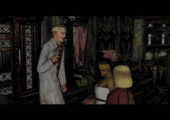
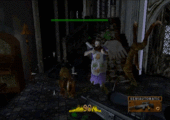
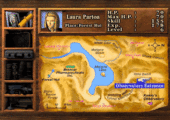
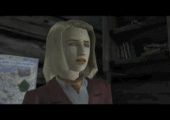
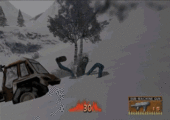
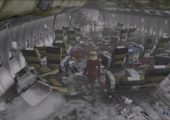
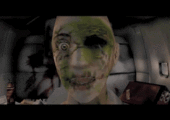
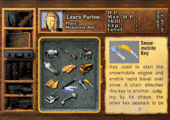

I LOVE that game. The atmosphere here is amazing, and I like this one much better than the original D on the Saturn. There is something about the story and situations that make up for the gameplay issues. It kind of remind me of the game “Deadly Premonition”, another game where the atmosphere was so cool that the technical limitations and poor design choices didn’t actually matter. Highly recommended.